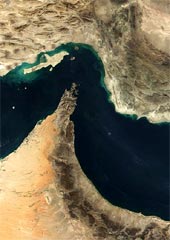Creating an Enemy of Iran
Are there untested diplomatic approaches that might reduce the risk of a conflict between the United States and Iran?
February 6, 2012

As we recently discussed international political events, a friend told me, “Countries are like people: They react in the same manner.” I didn’t quite realize the full import of her words until now that I view the seemingly inevitable path to war between the United States, Israel and Iran.
There are abundant historical examples to prove that an effective weapon in creating antagonism between countries as a prelude to war is by dehumanizing the enemy. Although the Holocaust during World War II and the Rwandan genocide are extreme cases of enemy dehumanization, a similar process exists almost every time there is war.
This is also true in the case of Iran, whose leaders have described their enemies pejoratively. However, that same language has also been used in describing Iranians, which further exacerbates an extremely delicate situation.
Anthropologists Ashley Montagu and Floyd Matson wrote that dehumanization could be considered the “fifth horseman of the apocalypse” because of the damage it has caused society. They wrote, “The possible attainment of full humanness — the transformation of the species from Homo sapiens to Homo humanus — rests upon our recovery of the lost world of fellow feeling, the source of all human connection.”
In a beautiful but harrowing poem entitled “How to Create an Enemy,” Sam Keen, an American philosopher and professor, expresses similar feelings:
Start with an empty canvas
Sketch in broad outline the forms of
men, women, and children.Dip into the unconsciousness well of your own disowned darkness
with a wide brush and
strain the strangers with the sinister hue
of the shadow.Trace onto the face of the enemy the greed,
hatred, carelessness you dare not claim as
your own.Obscure the sweet individuality of each face.
Erase all hints of the myriad loves, hopes,
fears that play through the kaleidoscope of
every infinite heart.Twist the smile until it forms the downward
arc of cruelty.Strip flesh from bone until only the
abstract skeleton of death remains.Exaggerate each feature until man is
metamorphosized into beast, vermin, insect.Fill in the background with malignant
figures from ancient nightmares — devils,
demons, myrmidons of evil.When your icon of the enemy is complete
you will be able to kill without guilt,
slaughter without shame.The thing you destroy will have become
merely an enemy of God, an impediment
to the sacred dialectic of history.
Is there, one wonders, some other way to face what seems to be an inevitable rush to widespread destruction and death? I believe there is. Untested diplomatic approaches could be applied in the current situation with Iran.
A possible first step before time runs out is to declare a moratorium on confrontational actions from both sides, while making an effort to know the other better. This could be achieved through a series of exchanges of scientists, doctors, artists, students, and sportspersons among the countries in conflict.
The recent rescue at sea from Somali pirates of 13 Iranian fishermen by American sailors shows what these kinds of actions can do to improve relations among people in conflict. Iranian fishermen could not hide their appreciation to the Americans for their rescue. We can make a conscious effort to create an atmosphere for peace with the same steadfast determination we use to create an atmosphere for war.
This approach will probably be dismissed as hopelessly naïve by many learned pundits. It does not conform to their idea that Iran is a devious power that will only respond to force.
However, there can be no peace if an atmosphere of peace is not created among the common people. All other options have so far been ineffective. This is the moment to give a constructive proposal a try.
